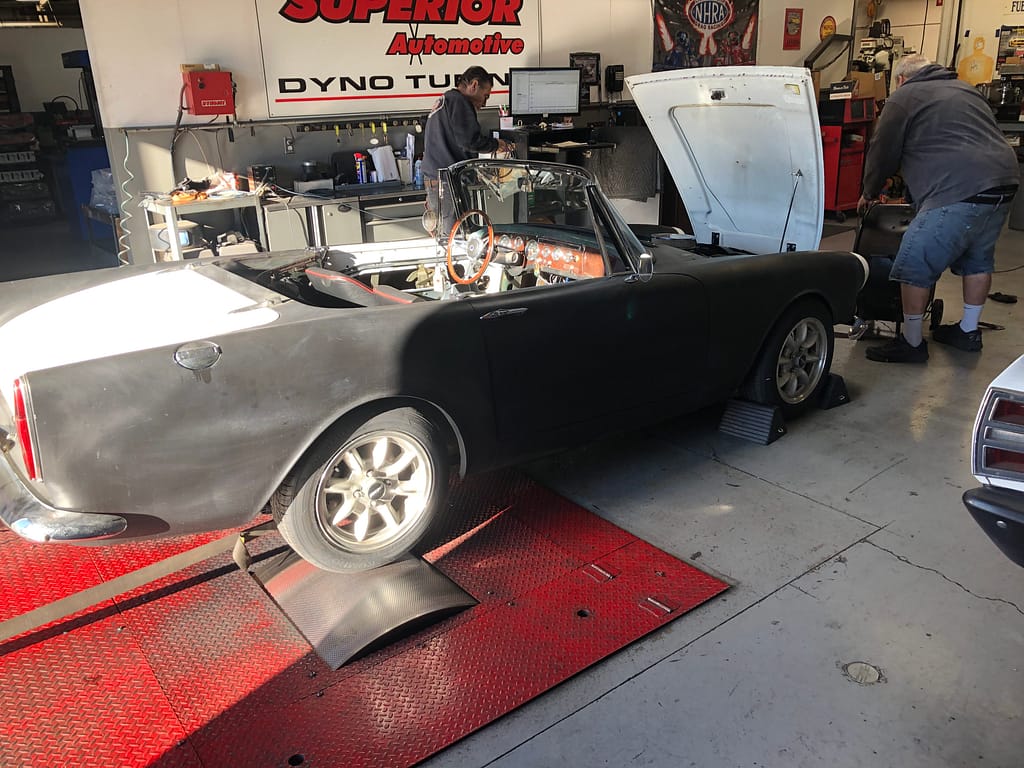
At this point in the project, the car was running, registered, and ready to hit the road. With a new set of tires, we decided to ensure the car was tuned properly and wasn’t running too rich or too lean. We also wanted to know the horsepower rating of the engine. Since we didn’t know the specific details about the bottom end of the engine, we were eager to find out how the engine was running. As for the horsepower range, we were hoping for around 150 hp. We wanted 200 hp, but common sense and experience dictated we could realistically expect 140-150 hp. Through members from the Sunbeam forum and the local Tiger Club, we heard about a shop called Superior Automotive Engineering. This business is the real deal. It is the spot to get your classic vehicle dyno tuned. I called them up and booked a slot.

Before our time at the dyno, I decided to look into what primary and secondary jets and power valves we should be running in the car for optimal performance. After much research, I happened upon a book that dives deep into the Ford V6 performance. The book is “How to Build and Modify Ford 60 Degree V-6 Engines, by Sven Pruett. The book was published in 1994 and is still very much relevant. The book dives deep into what needs to be done to eke out every ounce of horsepower from these engines. There is no stone that this book doesn’t cover. Based on our intake manifold and carburetor, we were concerned with what jets and power valves I was to use for our setup. The book focused on exactly the carburetor we installed, a Holley 8007, and recommended the exact jets.





In the carburetor section, the exact recommendation of a jet size of #51 for the four-barrel intake and carburetor was given. The book even identified elevation recommendations. Since we were located only a couple hundred feet above sea level, we decided to stick with the stock #51 jet size for the dyno tune. Since we had decided to install a secondary metering block for the 4-barrel carburetor, we turned to the book for guidance in selecting this jet too. The book also recommended the #59 jet size which comes stock with the secondary kit. It is a true testament to the book on the depth of research Sven went to capture all of this information and place it right into the hands of hot rodders.


The last item we had to verify was the power valve. Sven’s book once again delivered by recommending a 6.5 in Hg power valve. This too was a stock part from the Holley carburetor. This was confirmed from the previous tuning by trying to change to a 5.5 in Hg power valve with poor results. Now that the jet sizes and power valves were confirmed it was time to speed on over to the dyno shop and see what she’s got.

I pulled up on a sleepy Saturday in the morning and the shop was ready to get started. The shop has been around for generations and has tons of history. Originally opened in New York, the family migrated to So Cal years and years ago. I got the vibe that they knew exactly what they were doing. All of the people I spoke to about the shop said this was the place to go. The car was put up on the dyno, strapped in, and readied for the tune. There were tons of tinkering with all the screws on the carburetor and timing before they decided to do a power run.


The power run finally came and the results were a little disappointing. When the engine reached 4,700 rpm the belts started squealing and he had to cut short the test. The shop didn’t want to risk damaging the engine but they were sure the belt was slipping on a painted pulley wheel. They recommended I sand down the pulley. The max horsepower rating was 109.7 hp at 4,750 rpm with 136.11 lb-ft of torque. This was disappointing since I thought I had taken care of everything to prepare for the dyno run. To soothe my damaged ego, I reached out to a fellow owner of a Sunbeam Alpine V6 and asked to compare their values. I compared my power curve with theirs and found up to 4,750 rpm, both horsepower ratings were almost identical. If the car had been allowed to go up to 6,000 rpm, I think the engine would have landed in and around the 140-150 hp range. Unfortunately, dyno runs are not cheap and to do the dyno run another time would have been expensive.
However, the silver lining of the whole situation was that the air-fuel ratio was perfect for the car. The ratio was right where the shop wanted to see it. This gave us the confidence of driving the car knowing the tune was perfect for the engine. On a bittersweet note, after the run I went home and sanded down the pulley and the sound immediately went away. Although it was kind of a bummer we didn’t get the exact horse power number we were looking for, we were content that the power number was close to where we were aiming and the jets, power valve, and timing were all tuned. Motor on.

